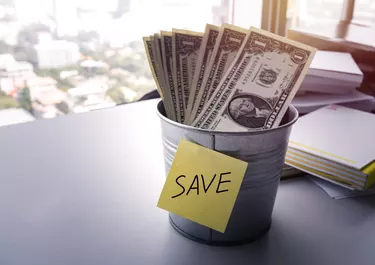Almost all Americans have suffered a significant financial setback at one time or another. Debt.org indicates that 96 percent of us have suffered a drop in income of 10 percent or more at least four times in our lives. That makes a good argument for saving money - as most financial advisors agree, but saving isn't without its challenges when there's just about enough money to pay your monthly bills and meet your other monthly expenses. for this reason alone, it might be a bit easier if you pay yourself first with automatic savings in the form of automatic transfers to savings to meet your financial goals.
Paying Yourself First
Video of the Day
Paying yourself first involves tucking some money into savings before you dedicate what's left to paying bills. You're making saving a priority. Move money into your savings account as soon as you're paid. Other expenditures and expenses follow from there. Some experts suggest opening a bank account at a different institution than the one you use for your checking account, the theory being that if the money is out of sight, it's also out of mind.
Video of the Day
And yes, you should definitely open and use a separate savings account. Money that remains in your checking account whispers, "Spend me!" That can be a tough temptation to overcome.
Consider also: Are You Spending Too Much
The Concept of Autopay
Autopay provides another approach to the out-of-sight, out-of-mind goal. It sets up automatic payments from your account. Autopay is most commonly used to schedule payments that you must make on a regular basis, such as for your rent, mortgage or a credit card, but you can use it as a savings tool as well. Your bank will make these payments for you so they're always on time and you don't incur any late fees.
Consider also: How to Set Up Automatic Payment for Capital One Credit Card
You might consider depositing your paychecks directly into your savings account. Then set up autopay to divert 90 or 95 percent of that money into your checking account to cover your bills and expenses. You can only spend what goes into the checking account, so you're literally paying yourself first rather than saving what's leftover at the end of the month.
Of course, you can also do the reverse – schedule autopay to send 5 or 10 percent of your checking account deposits to savings. But putting your entire pay into savings first eliminates the need for willpower.
Your Savings Goals
It's a good feeling to know that you have money tucked aside if life throws you a curveball, but you might also want to set up an autopay savings system to save money for long-term goals like retirement or a down payment to buy a home. You're not confined to holding just one savings account that's dedicated to financial emergencies. You can set up more than one to accommodate other goals as well.
Think of that first savings account as your emergency fund, something that experts strongly recommend everyone have. Aim to save at least three months' worth of your regular living expenses. Six months' worth is even better. The idea is that the money is there to sustain you in the event that you lose your job or suffer another financial catastrophe that leaves you with no income for a while.
Consider also: Here's How Easy It Is to Build a Mini-Emergency Fund
What Could Possibly Go Wrong?
Using your savings account for your payday deposits has another advantage. Ideally, you won't be taking other withdrawals from savings.
Automated withdrawals from checking to savings could cause you to bounce other payments if your autopay leaves insufficient funds to cover other payments you've set up. The result could be a deluge of overdraft fees. Your autopay from savings to checking should be the only debit you have to worry about each pay period if you start by depositing your pay into savings, then move most of that money to checking for paying bills.
- Northwestern Mutual Life Insurance Company: The Pros and Cons of Putting Your Bills on Auto-Pay
- Southland Credit Union: Saving Strategy – Pay Yourself First
- United Financial Credit Union: Pay Yourself First
- Debt.org: Building an Emergency Fund
- Consumer Financial Protection Bureau: An Essential Guide to Building an Emergency Fund
